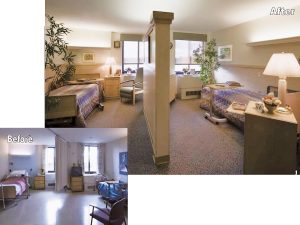 Nursing homes that are involved in culture change are moving toward person-directed care, meaning care is directed by the people they are caring for and it meets their needs as individuals. They are working to ensure self-determination, choice, dignity, and meaningful relationships for those who live and work there, as well as involving families and friends to create community. Culture change is causing all types of long-term care settings to focus on person-directed care, as well as care in the home. However, nursing homes serve as a good example of what is changing because they are often the most institutional long-term care settings.
Nursing homes that are involved in culture change are moving toward person-directed care, meaning care is directed by the people they are caring for and it meets their needs as individuals. They are working to ensure self-determination, choice, dignity, and meaningful relationships for those who live and work there, as well as involving families and friends to create community. Culture change is causing all types of long-term care settings to focus on person-directed care, as well as care in the home. However, nursing homes serve as a good example of what is changing because they are often the most institutional long-term care settings.
The chart below illustrates some of the differences between traditional nursing home care and person-directed care.
Moving From Traditional to Person-directed Care
| Traditional Care | Person-directed Care |
| Residents are told when to wake up, go to bed, eat, and bathe, based on institutional schedules and set routines. | Residents wake up, go to bed, eat, and bathe when they choose to. Staff alter their work routines to honor residents’ preferences. |
| Residents frequently have different care staff. The staff do not know the residents well, so they are not familiar with their preferences. Studies find that residents often feel unknown, insecure, or scared. |
The same staff take care of the same resident; they know each other and good relationships develop. This motivates staff to provide better quality care. Studies show that residents feel more secure, content, and happy. |
| Management makes most of the decisions, often without consulting the residents, families, or direct-care staff. |
Management seeks input from residents, families, and staff before making decisions that affect their daily lives. Management also trains and supports staff to enable residents to make decisions. |
Person-directed care is appropriate for all residents, even those with some type of dementia, such as Alzheimer’s disease. Residents with dementia are often unable to verbalize what they want, need, like, or don’t like. The nursing assistant who consistently works with such a resident knows this information by the resident’s body language, behavior, and/or information provided by the family. For example, a person with dementia may not be able to understand that she needs to be clean and, by her words and actions, refuses a bath or shower. A well-trained direct care worker, who knows the person, will have the knowledge, skills, flexibility, and equipment to find new and better ways to pleasantly assist her with washing.
A resident’s daily quality of life and ability to make choices will not be likely to improve through environmental changes only. Using bathing as an example, a beautiful spa-like room is of little benefit if the residents are still bathed on a rigid schedule or against their will. A beautiful spa-like room that is easily accessible, and used when a person is invited to bathe at a time that the person is used to and the person is given a choice of shampoo type and is talked through the steps of showering in a respectful and safe way is an example of environmental and communication culture change.
Need help making some healthcare decisions? Read more at What are my Care Options?

